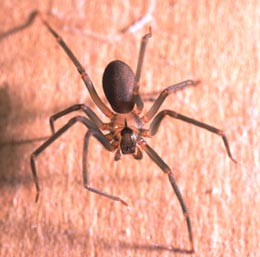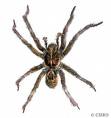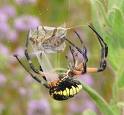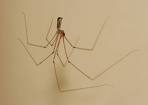SPIDERS
One of our most valuable controllers of insects
is the Spider, that insect -eating member of the family of invertebrates. All
true insects have only six actual legs, but every spider has eight. Spiders are
best know for their webs. Some live in the ground and some have nest in tree as
the commonly adorned house structure or barn. There are hundreds of spiders but
only two are really one to be concerned about. Spider infestation can be evident
by their webs. Also, at the end of the winter one my find an undusted windowsill
cluttered with moth wings. These are the leavings behind of unwanted parts of
their food source that spiders have thrown out. Much to their desire is
the body of their prey but care little for consuming the wings. When knowing
that your house has a spider population it would be considered wise to be on the
ware of which species you are dealing with. Also be aware that a spider could
loose it's footing if you move to quickly in it's domain. By moving boxes or
stored items in the garage be extra mindful of what lurks behind them. You just
might flush one out.

The control method for spiders is a very
delicate operation to be performed. The pest control operator must know the best
treatment method and insecticide to use. There are more treatment applications
that do not work satisfactory then ones that do and it is up to the "Bug Guy" to
know the differences. Nature King Pest Management will only use the best
registered product available for the control and removal of a spider problem.
One that the spider cannot detect before he gets to it.
Black Widow Spider
Although spiders in general produce venom with
which to paralyze their prey, only a few have fangs of sufficient length or
power to penetrate human skin or venom of sufficient quantity or potency to
affect human health. There are two types of poisons present in spider venom:
a toxin that will cause local symptoms, and a toxalbumin producing general
symptoms. The latter described is of the Black Widow. The fangs which are about
1/15 of an inch in length, serve to inject from two large glands. The venom is
reported to be much more virulent per unit than that of the rattlesnake. Yikes!

Black Widow Spider
Brown Recluse Spider
This Spider is about is approximately 5/16 inch
in length, dark brown to tan with long legs. A violin-shaped on the upper side
of the cephalothorax (head portion) is the only noticeable identification giving
rise to the nick-name- fiddleback spider. This spider lives up to it's name but
can be found in fields, rock piles, as well as your garage or closet. A lot of
bites occur from these spiders taking up refuge in clothing that be in those
closets. The bite of the Brown Recluse usually cannot be felt by the victim and
pain is little or none at time of bite. Only after 2 to 8 hours does pain start
to be noticed from mild to severe. After several days an ulcer will appear. The
venom seems to have a spread factor that resembles necrosis or tissue
destruction. The venom injected by the Brown Recluse is not really a toxin but a
complete chemical that inhibits the normal action of infection-fighting
antibodies in the human anatomy. Almost always the only relief is a doctor
visit.

Brown Recluse Spider
Other spiders that are considered pest
There are many other spiders that are
considered pest but are not venomous to the point if concern.
 1. 1.
 2. 2.
 3.. 3..
 4. 4.
 5. 5.
 6. 6.
1.Common Wolf Spider 5.Juming Spider
2. Barn Spider
6.Crab Spider
3. Black and Yellow Orb Weaver
4. Daddy Long Legs Spider
copyright protected 2010 |